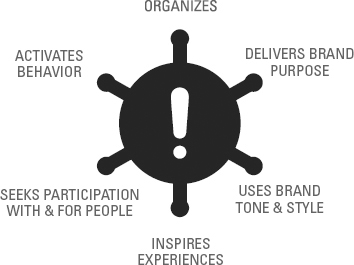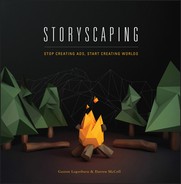
CHAPTER 09
THE ORGANIZING IDEA
Inspiring Experiences That Change Behavior and Drive Transactions
We have now introduced the working model and all four pillars that hold up an Organizing Idea: Brand Purpose, product/service positioning, understanding of consumer emotions, and understanding of consumer needs. You’ve also learned the importance of and the difference behind creating a world instead of just creating ads. So now it’s time to dig into one of the keys to unlocking the creation of your world—the Organizing Idea. Why? Because an Organizing Idea does just that; it organizes. Organizes what? you may ask. It organizes the connections between your consumer and your story in a way that builds emotional association and inspires behavior. It’s a strategic input and sometimes, just sometimes, it may also be a creative expression. Organizing Ideas have the ability to help define how your brand interacts with the consumer. Even the very premise of what content you create, curate, or associate can be enhanced by leveraging it against an Organizing Idea. It’s a powerful concept that unlocks great effectiveness in how your story is told, delivered, engaged with, and experienced.
Your Organizing Idea is built from the four pillars of insight and knowledge you develop around your brand and the consumer. We have covered each of these pillars in depth in the previous four chapters. Having a true and meaningful connection to your Brand Purpose is integral; your Organizing Idea becomes part of how you bring that Purpose to life. Without a connection to the Brand Purpose, your Organizing Idea is nothing more than another random idea.
As expressed in Chapter 6, the positioning of your product or service is an equally important pillar. You’ll need a very clear perspective on what you offer, why you’re offering it, and how you are going to deliver it; otherwise, the behaviors that you’re seeking to create from Storyscaping will be less effective. The Organizing Idea serves to guide the type of experiences that are created and how those experiences are connected through a Story System. If you do not have a fundamental connection to the product or service positioning, everything you do will be less efficient in driving the ultimate response of a transaction.
The previous chapters on consumer insight prove how important it is to understand the emotional desires of consumers. The Organizing Idea fuels that emotional territory. To ensure the manner in which behaviors are inspired and immersive experiences are created, your Organizing Idea must have relevance and an association to consumer insight. This is key in keeping the desired connection in line with the purpose. Real consumer insight is often the foundation for the most creative solutions, particularly in the area of communication and the telling of the story. Truly understanding the emotional toils or cultural influences of a consumer is priceless. No amount of effort, exploration, or discovery is too much when it comes to finding fresh and authentic insight. It pays to explore all the dimensions of a consumer. We should explore at the widest level while taking the following into consideration: cultural insight, category insight, competitive insight, and the deepest level, insight into consumer emotion.
Finally, you gained a clearly defined view of how a consumer interacts with people, places, and things. Often illustrated as a consumer journey, knowing and following these interactions is foundational to understanding what and where behaviors exist. This information provides insight into how interactions may be harnessed, changed, or amplified. This effort is not as simple as looking at a day in the life of a consumer. We need to go deeper and understand the emotional journey and how that sentiment relates to their behavior.
Using these pillars, we can explore how to establish an effective Organizing Idea. First, we must understand what it is we are creating. We define an Organizing Idea as “an active statement that defines what the brand must do to change consumer behavior. It inspires the type of experiences that are created through the Storyscape.”
An Organizing Idea is not a big idea. A big idea is the creative expression or the OMG experience that delivers to an Organizing Idea.1 Red Bull is an amazing brand, a content brand that is connected with big ideas—really big ideas, like a guy riding a balloon to space and jumping out of it. Now that is a big idea, but it’s not an Organizing Idea. Let’s explore that a little. Red Bull has many big ideas, partnerships, content, and distribution channels.2 How does it get value from them all? The value appears and appreciates because they are all connected to an Organizing Idea. An Organizing Idea for Red Bull could be something like “take flight,” which is beautifully expressed as, “Red Bull Gives You Wings.” Starting from an idea like “Red Bull Gives You Wings” gives you real options to organize around. That’s why, when a crazy (in a good way) guy wants to jump from a balloon in space, you say, “Hell yeah that works.” It works because it is in line with your brand, it connects with your product through energy, it engages consumers that are content driven, and it excites emotionally. And even more than that, it brings to life the Organizing Idea of “Red Bull Gives You Wings.” When you look at Red Bull Flugtag, Joyride, Cliff Diving, and X Games sponsorships, you see that many of its connections and associations link to its Organizing Idea. And most important, the role of product is undeniable. This enables each Red Bull experience to lead to another without brand disconnect, even though the experience may be around different content.
Let the Creation Begin. Creating an Organizing Idea is not a science; there is no formula. There are inputs and insights but not a formula that guarantees a great idea. If there was a formula, ideas would no longer be the outcome of creativity. What we can offer you is a way to test whether you have an Organizing Idea or not. We see it more as a craft—a craft that comes from the input of many people. It’s a recipe of sorts—the main ingredients being instinct, gut feeling, experience, and passion—mixed into a melting pot of opportunity. The way you want to approach this dish is by finding a balance between being strategically minded, and at the same time, inspiring. That’s why it’s a craft; it’s built on teamwork.
We utilize an approach called connected thinking, where the outcomes of multiple opinions from different dimensions are more powerful than the view of one lone genius. That’s not to say that having a genius contribute isn’t valuable, of course it is, but it’s just one dimension. An Organizing Idea has multiple perspectives supporting it. At the same time, an Organizing Idea has a far-reaching application. This is why connected thinking is a critical foundation for ensuring the exploration of opportunities, while ownership of the idea remains shared. Plus, this process of collaboration builds understanding among people from the outset.

When crafting and creating an Organizing Idea, we are looking for key characteristics that deliver on the pillars.
Here are some initial questions to ask yourself as you try to develop your Organizing Idea:
We’ve offered a series of aspects that we look for in an Organizing Idea, but again, it isn’t a science. Assessing a few words of thinking is not a definitive task. This is why experience, multiple perspectives, and forethought are applied. You have to imagine the creative expressions and experiences that the Organizing Idea is part of. Often the Organizing Idea is not formed in isolation of exploring creative expressions and territories. It’s not a passing-of-the-baton process between an Organizing Idea to a big idea and so on. It’s an organic, interactive, and creative process.
What to Avoid. Creating an Organizing Idea is a new concept. We have explained how it differs from a big idea. From a strategic point of view, sometimes it helps to explore what to avoid. So, here are some things to watch out for when creating your Organizing Idea.
If you are now starting to think about what your brand’s Organizing Idea might be or have done so while reading this chapter, you are right on track. If not, then please begin that process. If you have identified an Organizing Idea but are not sure whether it is right, just keep in mind that capitalizing on the power of an Organizing Idea requires some organizational shift in perspective. If you are not able or willing to define decisions around how to deliver your brand, build experiences, create content, tell stories, plan media, or define commerce channels with an Organizing Idea, you risk the true effectiveness that can be achieved. This is where we see many organizations are being challenged. Use this challenge as your fuel for positive change within your company. Believe in an Organizing Idea and strong Purpose that drives and builds immersive experiences—doing so can catapult organizations to new levels of efficiency and effectiveness and even increase the value of brands and your business as a whole.
Over the last decade, Coca-Cola unearthed the power that a strong application of Purpose and an Organizing Idea can achieve. And they still never sacrifice creativity, story evolution, or consumer engagement. Back in 2003, the Coca-Cola brand used the slogan, “Coca-Cola . . . Real” but there were many different ad campaigns that played out around the world. In 2005 they adopted the slogan, “Make it Real” and continued with a variety of diverse advertising campaigns across the world, and the casual observer could think that the brand and slogan were the only link between them. But in 2006 they started to consolidate as a global brand around the positioning of “The Coke Side of Life”3—a powerful, consumer-relevant idea. A couple of years later, you could start to see how the brand was more consolidated to the idea, not just the tagline. A few more years down the road the work became more aligned to their Purpose, when they focused around the Organizing Idea of “Open Happiness.” Now the majority of marketing effort appears to be behind one idea platform.4 They continue to create many different and great stories and experiences of the brand, and you can see they are all true to “Open Happiness.” This illustrates that Coca-Cola has streamlined globally—from having many different communication ideas and ad campaigns only connected by the slogan—to being centered around one core idea. Can you imagine the impact and effectiveness that would come from this global level consolidation, as consumers are more globally connected? Oh, and if that wasn’t enough value, please also note, their share price is 174% of what it was in 2003.5
Now that you have an understanding of the strength and importance of an Organizing Idea, let’s explore how to apply an Organizing Idea within the creation of Story Systems.
Utilizing an Organizing Idea is a powerful new concept for marketing. With it, you can create worlds of experience that are inherently connected to the four pillars: your Brand Purpose, product and its positioning, the consumer on an emotive level, and the consumer on a behavioral level, from newly defined opportunities and insights. The next step is the application of an Organizing Idea to the Experience Space. It’s where the Organizing Idea helps define the role of channels, the story line connections, and the types of experiences that matter.
